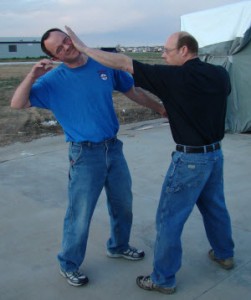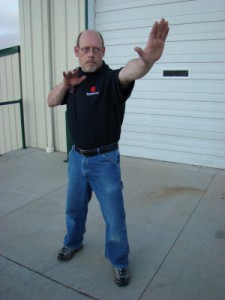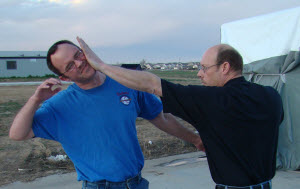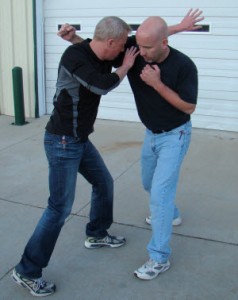 One of the most amazing things about the traditional martial arts—especially those that focus heavily on the practice of solo forms (kata, in Japanese)—is the idea that practitioners often debate the meaning and application of the movements of those forms. While the meaning of most movements can be readily identified as a punch, kick, etc., other movements are open to interpretation and therefore often the subject of intense disagreement.
One of the most amazing things about the traditional martial arts—especially those that focus heavily on the practice of solo forms (kata, in Japanese)—is the idea that practitioners often debate the meaning and application of the movements of those forms. While the meaning of most movements can be readily identified as a punch, kick, etc., other movements are open to interpretation and therefore often the subject of intense disagreement.
When I first got involved in the martial arts, the idea of “breaking the code” of such movements and discovering the hidden secrets of forms was fascinating to me. As I got deeper into the arts and began to see how other practitioners analyzed certain movements, I came to the conclusion that many motions could have multiple practical applications. It didn’t have to be “either/or.” It could be “both” or even “all.”
I also came to the conclusion that, no matter how hard I tried, some movements just didn’t make sense. The explanations and applications that were offered for them were not practical and, even if I trained them diligently, I would never be comfortable relying on them in a real self-defense situation. With that realization, I purposely moved away from the traditional martial arts and began to focus on practical self-defense, or what these days is often generally referred to as “combatives.”
Meaning and Application of Movements
While many traditionalists will argue that, in time, I would have understood the deeper meaning of the movements, I stand by my decision. The reason is simple: If I am attacked between now and whenever that “revelation” happens, I won’t be fully prepared to defend myself. More importantly, if I spend my training time practicing movements that I don’t fully understand and can’t apply reliably in a real fight, I’m not training for self-defense. The “wax on; wax off” (or perhaps more appropriately, “wax on; whack off”) approach may be fine from a martially artistic perspective, but it is not the shortest or most efficient route to developing practical personal-defense skills.
In the traditional Japanese martial arts, bunkai is the combat application of a movement. Typically, this defines and demonstrates what the movement is intended to be used for in a defensive situation. In other words, bunkai defines what a movement “is.” The Japanese also use another term to describe application: oyo. Oyo is more of a “free-form” application that encourages students to apply techniques more fluidly and spontaneously. Rather than “what is,” it refers to “what it could be.”
Bob Orlando is an extremely talented martial artist and instructor based in the Denver area. A practitioner of Indonesian Kuntao and Silat, he has also devoted a lot of time and effort to the analysis of traditional forms to extract useful applications. When it comes to defining the function of a movement, he sums it up eloquently as “What it does is what it is.” In other words, a movement is a movement. Once it is put in context, it may be a block, a strike, a lock, or something else, depending on what that context is. And from a functional standpoint, the more things you can do with a particular movement, the more useful and worthwhile it is.
The Gun Analogy
If you’re a gun guy, you’re probably wondering what (or possibly if) all this martial arts stuff has to do with you, so let me make it relevant.
Let’s use the example of loading and chambering a round into a semiautomatic pistol. You know the procedure well: Gripping the gun firmly in your firing hand with a finger off the trigger, you insert the magazine and smoothly seat it home with your palm. If you’re combatively oriented (as you should be), you reach over the top of the slide (a gross-motor-skill movement that affords more mechanical advantage and surface-area contact than a thumb/index finger pinch grip), pull it smartly to the rear, and release to allow the slide to strip a round from the mag and drive it into the chamber. Again, that should all be very familiar to you.
Now let’s look at the same sequence, but in a different context: Rob Pincus’ non-diagnostic linear malfunction clearance method. Let’s say you’re in the middle of a firing string and hear a click instead of a bang. Instantly, you flow into a “tap, rack, ready,” slapping the base of the magazine to ensure that it’s seated, reaching over the slide, pulling it to the rear, releasing it, and getting back on target. While some will argue that your goal in that sequence is to eject a bad round and chamber a fresh one, if you take an honest look at the steps involved, you’ll see a lot of “common ground” with the sequence of loading the gun and chambering it: with the exception of inserting the magazine, everything else is literally the same. And the more things you already know, the fewer things you need to remember or learn in isolation.
If you consider a simple malfunction clearance sequence, like clearing a stovepipe, the process is again the same—especially if you ensure that your standard technique of racking the slide includes an outward cant of the gun that allows a stovepiped case to fall free.
A complex malfunction still shares a lot of common ground with our basic sequence. When you realize there’s a problem with the gun, you try to tap and rack. When that doesn’t work, you add to the racking sequence by locking the slide to the rear, physically stripping the mag, and working the slide using established technique. Then you’re back to the original sequence of loading and chambering a round.
As you can see from this example, efficient gun handling acknowledges that the same mechanical actions can be used to resolve different issues. What it does (seats a magazine, clears a dead round, clears a stovepipe, chambers a fresh round) is a direct result of what it is without burning brain cells analyzing and lamenting what it is. To quote Nike, “Just do it.” If you’ve taken the time to choose and practice the right “it,” you’ll probably solve your problem. In the process, you will also have streamlined your training, simplified your skill set, and empowered yourself to react more reflexively because you have fewer decisions to make.

First motion of author’s default empty-hand sequence: drive the left arm straight out, palm forward. What is it? That depends on what it’s doing.
Back to Empty Hands
The idea of accepting a movement as a movement and allowing its function in context to define it is what I call “physiological potential.” Rather than arguing over what something “is,” we accept the fact that it can be many things and explore which of those things are most practical and functional.
With that concept in mind, my approach to empty-hand tactics focuses on simple sequences of movement that are, by design, very versatile and multi-purpose. When applied in different contexts, the multiple functions of each action in the sequence automatically kick in. Regardless of the exact dynamics of the situation, they provide effective and efficient combative function that allows you to stay safe and bring a quick and decisive end to the situation.

An obvious function of this movement is a palm strike. If it turns the attacker’s head toward his right shoulder, it also prevents him from punching effectively with that arm.
In a very basic sense, it serves as a gauge, allowing you to touch a target, register its location and range, and better enable your other hand to hit it. This is an instinctive action of touch or grab/hit that is hard-wired into human combative behavior. An open hand to the face also obscures the attacker’s vision, so done properly, he never sees the other hand coming.

Extending your arm between the attacker’s head and his fist allows it to function as an “off ramp,” preventing the punch from landing and guiding it harmlessly down toward your armpit.
What if the hit is aimed at (or in the chaos of the struggle just happens to strike) the attacker’s shoulder or bicep instead? It then functions as a “stop hit,” killing the power of a punch or strike at its root rather than blocking the limb farther down. If your left palm happened to hit his head and turned it toward the shoulder of his punching arm, the same “stop hit” function results, since he can’t punch you and look away at the same time. Which is it? Yes.
Let’s say your aim is off or you purposely forego the stop hit and your straight left arm shoots out somewhere between his fist and his head. In that position, it serves as an “off ramp” that keeps his fist from hitting you and guides his arm down toward your armpit. The harder he hits, the better this works, making it one of the simplest and most effective defenses against the classic “haymaker” right punch.

Against an overhead strike, that same palm can function as a parry, driving the attacking arm across the attacker’s body to create an opportunity for follow-up strikes.
These are just a few examples of the multiple functions offered by the first movement of my preferred sequence. The other movements of the sequence flow naturally behind this one and also offer multiple offensive and defensive functions. The reason is not because they are special, super-secret techniques. On the contrary, they are basic, generic motions that are easily understood and easily applied. And like all movements, they have physiological potential. By keeping an open mind and exploring that potential consistently and repeatedly in training, you learn to harness it and trust it to work in the dynamics of an unpredictable incident.
Common Ground
I frequently describe a good learning process with the phrase “The more you learn, the less you know.” Rather than accumulating more and more technique and amassing disjointed skill sets, the goal should be to constantly search for common ground, similar patterns of motion, and multiple functions for the same actions. Instead of focusing on differences, concentrate on similarities. Ultimately, empty-hand tactics, improvised weapons, knife, stick, gun and all the other skills you train should begin to share more and more common ground.
Knowing less but understanding its full potential is a good thing. There’s less to remember and less to practice, yet ultimately it does a lot more.
Bruce Lee said something to the effect, "I fear an opponent who've practiced one technique a thousand times more than one who've practiced a thousand techniques one time." Great article! I totally get it. Keep it down to a level where one can "default" to a few good techniques that will keep you capable of getting to your self defense tool.